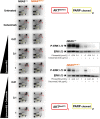Synthetic lethal interaction of cetuximab with MEK1/2 inhibition in NRAS-mutant metastatic colorectal cancer
- PMID: 27636997
- PMCID: PMC5347684
- DOI: 10.18632/oncotarget.11985
Synthetic lethal interaction of cetuximab with MEK1/2 inhibition in NRAS-mutant metastatic colorectal cancer
Abstract
KRAS mutations are an established predictor of lack of response to EGFR-targeted therapies in patients with metastatic colorectal cancer (mCRC). However, little is known about the role of the rarer NRAS mutations as a mechanism of primary resistance to the anti-EGFR monoclonal antibody cetuximab in wild-type KRAS mCRC. Using isogenic mCRC cells with a heterozygous knock-in of the NRAS activating mutation Q61K, we aimed to elucidate the mechanism(s) by which mutant NRAS blocks cetuximab from inhibiting mCRC growth. NRASQ61K/+ cells were refractory to cetuximab-induced growth inhibition. Pathway-oriented proteome profiling revealed that cetuximab-unresponsive ERK1/2 phosphorylation was the sole biomarker distinguishing cetuximab-refractory NRASQ61K/+ from cetuximab-sensitive NRAS+/+ cells. We therefore employed four representative MEK1/2 inhibitors (binimetinib, trametinib, selumetinib, and pimasertib) to evaluate the therapeutic value of MEK/ERK signaling in cetuximab-refractory NRAS mutation-induced mCRC. Co-treatment with an ineffective dose of cetuximab augmented, up to more than 1,300-fold, the cytotoxic effects of pimasertib against NRASQ61K/+ cells. Simultaneous combination of MEK1/2 inhibitors with cetuximab resulted in extremely high and dose-dependent synthetic lethal effects, which were executed, at least in part, by exacerbated apoptotic cell death. Dynamic monitoring of real-time cell growth rates confirmed that cetuximab synergistically sensitized NRASQ61K/+ cellsto MEK1/2 inhibition. Our discovery of a synthetic lethal interaction of cetuximab in combination with MEK1/2 inhibition for the NRAS mutant subgroup of mCRC underscores the importance of therapeutic intervention both in the MEK-ERK and EGFR pathways to achieve maximal therapeutic efficacy against NRAS-mutant mCRC tumors.
Keywords: KRAS; MEK1/2; NRAS; cetuximab; colon cancer.
Conflict of interest statement
The authors declare no competing financial interests.
Figures








References
-
- Bardelli A, Siena S. Molecular mechanisms of resistance to cetuximab and panitumumab in colorectal cancer. J Clin Oncol. 2010;28:1254–61. - PubMed
-
- De Roock W, Claes B, Bernasconi D, De Schutter J, Biesmans B, Fountzilas G, Kalogeras KT, Kotoula V, Papamichael D, Laurent-Puig P, Penault-Llorca F, Rougier P, Vincenzi B, et al. Effects of KRAS, BRAF, NRAS, and PIK3CA mutations on the efficacy of cetuximab plus chemotherapy in chemotherapy-refractory metastatic colorectal cancer: a retrospective consortium analysis. Lancet Oncol. 2010;11:753–62. - PubMed
-
- Misale S, Di Nicolantonio F, Sartore-Bianchi A, Siena S, Bardelli A. Resistance to anti-EGFR therapy in colorectal cancer: from heterogeneity to convergent evolution. Cancer Discov. 2014;4:1269–80. - PubMed
-
- Meriggi F, Vermi W, Bertocchi P, Zaniboni A. The Emerging Role of NRAS Mutations in Colorectal Cancer Patients Selected for Anti-EGFR Therapies. Rev Recent Clin Trials. 2014;9:8–12. - PubMed
MeSH terms
Substances
LinkOut - more resources
Full Text Sources
Other Literature Sources
Medical
Research Materials
Miscellaneous

